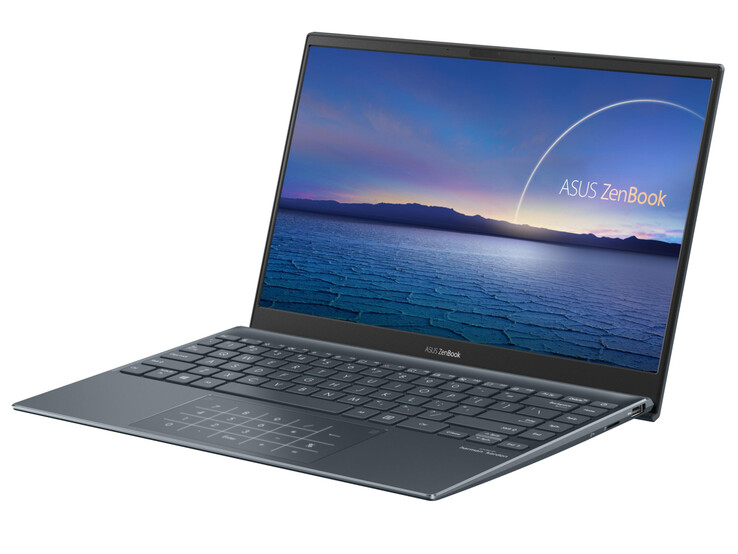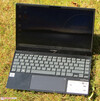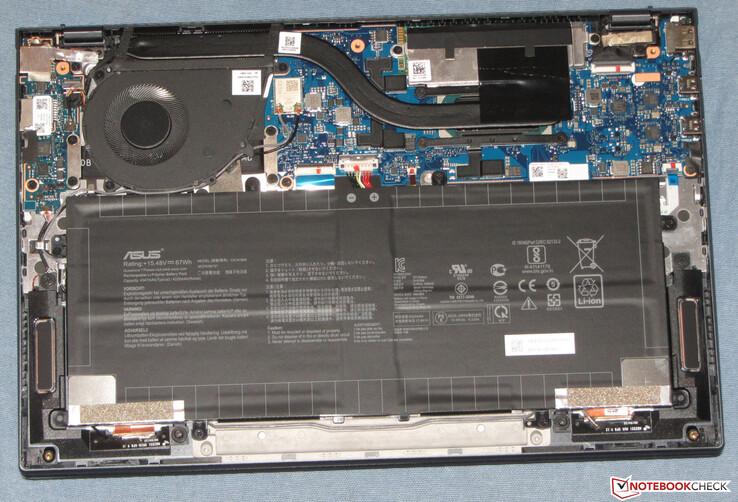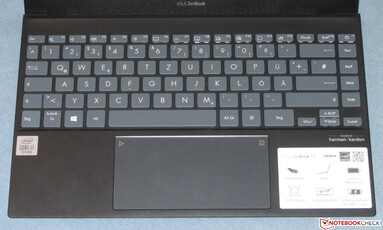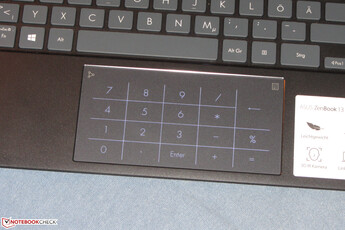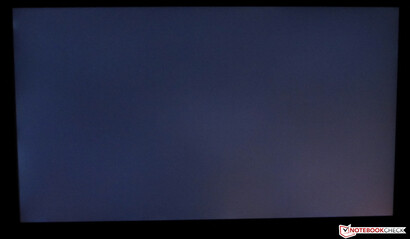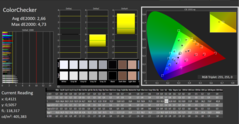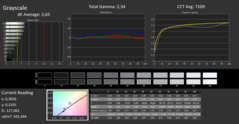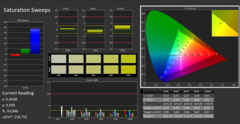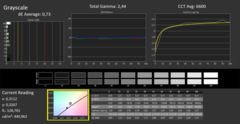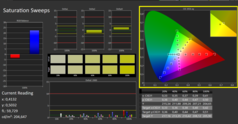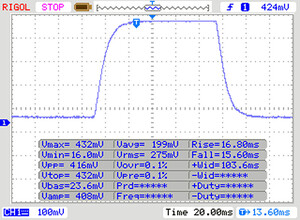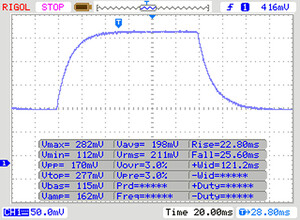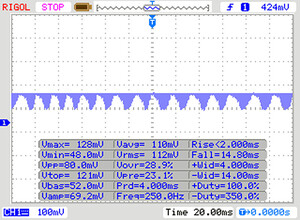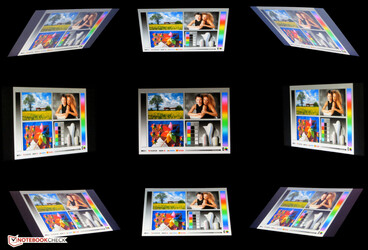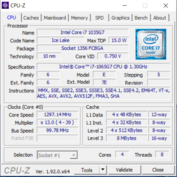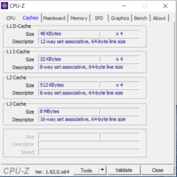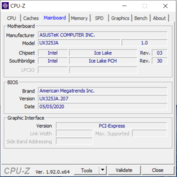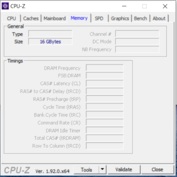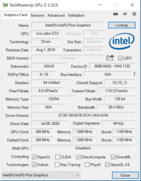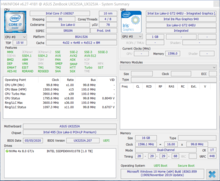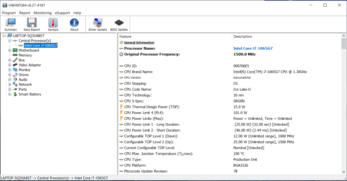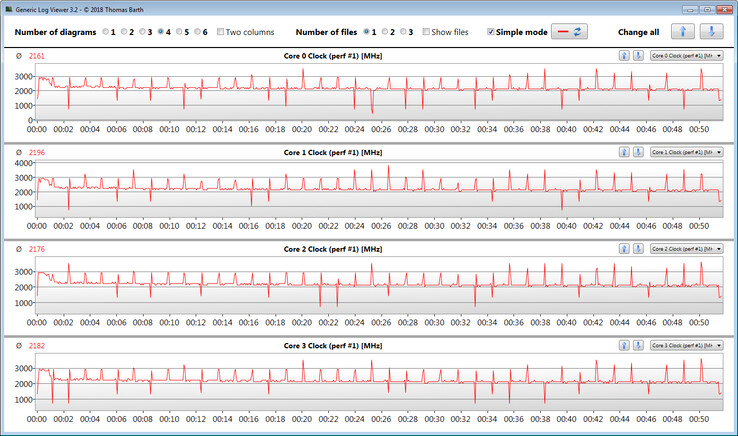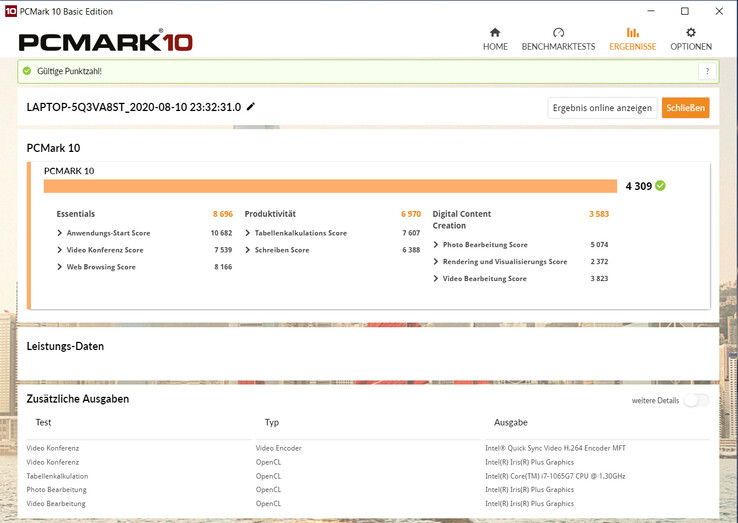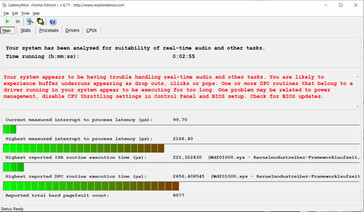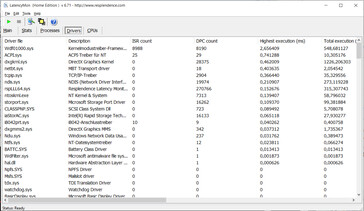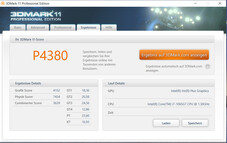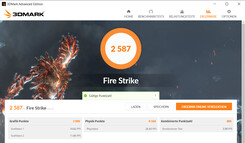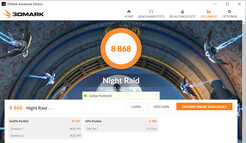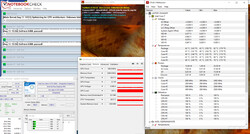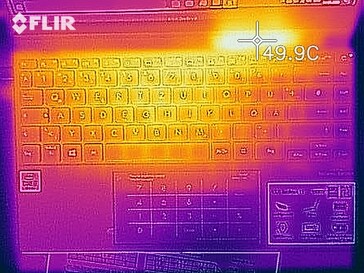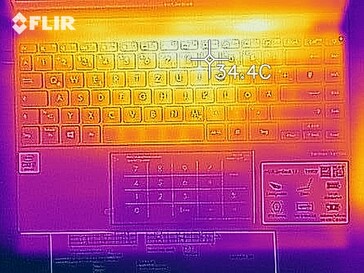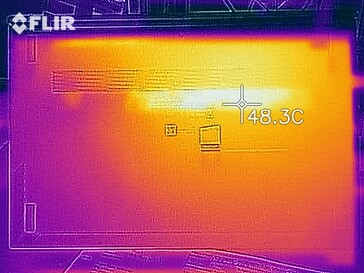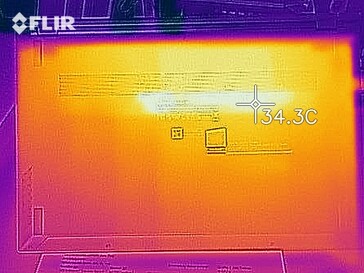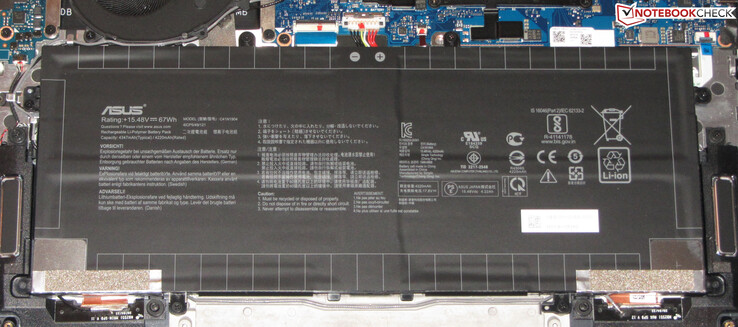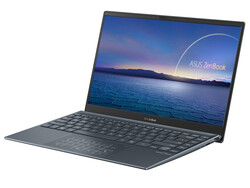Asus ZenBook 13 UX325JA in Review: 1100-gram Subnotebook with Excellent Battery Life

The Asus ZenBook 13 UX325JA is a compact, lightweight, 13.3-inch subnotebook. It is powered by a quad-core Core i7-1065G7 from Intel's Ice Lake generation. Its competition consists of devices such as the Samsung Galaxy Book Ion 13.3, Samsung Galaxy Book S, Acer Swift 3 SF313-52, Apple MacBook Air 2020, Huawei MateBook 13, and the HP Envy x360 13. The last of these devices is a 2-in-1 laptop. We have included it in this comparison due to the generally low availability of Ryzen-4000-based 13.3-inch subnotebooks.
Rating | Date | Model | Weight | Height | Size | Resolution | Price |
|---|---|---|---|---|---|---|---|
| 87.5 % v7 (old) | 08 / 2020 | Asus ZenBook 13 UX325JA i7-1065G7, Iris Plus Graphics G7 (Ice Lake 64 EU) | 1.1 kg | 13.9 mm | 13.30" | 1920x1080 | |
| 83.8 % v7 (old) | 07 / 2020 | Samsung Galaxy Book Ion 13.3 i5-10210U, UHD Graphics 620 | 970 g | 12.9 mm | 13.30" | 1920x1080 | |
| 85.1 % v7 (old) | 07 / 2020 | Samsung Galaxy Book S Intel i5-L16G7, UHD Graphics G7 (Lakefield GT2 64 EU) | 940 g | 11.8 mm | 13.30" | 1920x1080 | |
| 87 % v7 (old) | 02 / 2020 | Acer Swift 3 SF313-52-71Y7 i7-1065G7, Iris Plus Graphics G7 (Ice Lake 64 EU) | 1.2 kg | 16.6 mm | 13.50" | 2256x1504 | |
| 88 % v7 (old) | 04 / 2020 | Apple MacBook Air 2020 i5 i5-1030NG7, Iris Plus Graphics G7 (Ice Lake 64 EU) | 1.3 kg | 16.1 mm | 13.30" | 2560x1600 | |
| 84 % v7 (old) | 07 / 2020 | Huawei MateBook 13 2020 AMD R5 3500U, Vega 8 | 1.3 kg | 14.9 mm | 13.00" | 2160x1440 | |
| 85.5 % v7 (old) | 06 / 2020 | HP Envy x360 13-ay0010nr R5 4500U, Vega 6 | 1.3 kg | 16.4 mm | 13.30" | 1920x1080 |
Case - UX325 with a Metal Chassis
Our ZenBook comes in a slim, compact metal case with a matte, dark-gray (Pine Grey) finish. An alternative, bright purple (Lilac Mist) variant of the laptop is available as well. In most areas, Asus has continued to use smooth surfaces. The back of the lid has a concentric, brushed finish with the "Asus" logo as the centerpiece. When opened, the bottom edge of the lid serves as a stand that slightly elevates the back of base unit. As a side effect, the airflow is improved. The battery is fixed. Furthermore, there is no maintenance hatch on the laptop. In order to access the components, the case needs to be opened.
The clearances are even and there are no excess materials. The device also does not suffer from any major rigidity issues. While the base unit can be twisted with a sufficient amount of force, the rigidity is still good enough to not be a reason for concern. The same holds true for the lid. Regardless: A higher rigidity should not be too much to ask from a highly mobile 1,400-Euro (~$1,665) laptop. Applying pressure to the back of the lid does not create distortions on the screen. Although the hinges hold the lid firmly in place, there is some teetering. The display can be opened to a maximum angle of about 140°. The display can be opened with one hand.
The ZenBook matches competitors in terms of its dimensions. Here, the Acer Swift 3 SF313-52 is an exception due to its 13.5-inch display with a 3:2 aspect ratio that significantly increases its width. At a weight of just below 1,100 grams (~2.43 lbs), the UX325JA is only bested by certain Samsung models.
Features - ZenBook with Two Thunderbolt 3 Ports
Although the port selection of the ZenBook has been trimmed, it is well thought out. The laptop comes with two Thunderbolt 3 ports, both of which support Power Delivery and DisplayPort via USB-C. Combined with the HDMI port, the UX325 has a total of three video outputs. Additionally, a docking station or an external GPU can be connected.
A USB Type-C to USB Type-A adapter is not required. Instead, Asus has directly implemented a USB Type-A port (USB 3.2 Gen 1) in addition to the USB-C ports. However, a USB Type-C to headphone jack adapter is included in the package. There is no dedicated, combined audio jack.
SD Card Reader
The microSD card reader is one of the faster models. When transferring larger files, it achieves a maximum transfer speed of 85.5 MB/s. We also transferred 250 jpg image files (around 5 MB each) at 75.3 MB/s. We use our reference card (Toshiba Exceria Pro M501 microSDXC 64 GB) to test card readers.
| SD Card Reader | |
| average JPG Copy Test (av. of 3 runs) | |
| HP Envy x360 13-ay0010nr (Toshiba Exceria Pro M501 64 GB UHS-II) | |
| Samsung Galaxy Book Ion 13.3 (Toshiba Exceria Pro M501 microSDXC 64GB) | |
| Asus ZenBook 13 UX325JA (Toshiba Exceria Pro M501 microSDXC 64GB) | |
| Samsung Galaxy Book S Intel (Toshiba Exceria Pro M501 64 GB UHS-II) | |
| Average of class Subnotebook (18.4 - 142, n=13, last 2 years) | |
| maximum AS SSD Seq Read Test (1GB) | |
| Samsung Galaxy Book Ion 13.3 (Toshiba Exceria Pro M501 microSDXC 64GB) | |
| HP Envy x360 13-ay0010nr (Toshiba Exceria Pro M501 64 GB UHS-II) | |
| Asus ZenBook 13 UX325JA (Toshiba Exceria Pro M501 microSDXC 64GB) | |
| Samsung Galaxy Book S Intel (Toshiba Exceria Pro M501 64 GB UHS-II) | |
| Average of class Subnotebook (22.5 - 207, n=13, last 2 years) | |
Communication
The Intel Wi-Fi chip (Wi-Fi 6 AX201) supports the Wi-Fi standards 802.11a/b/g/n/ac/ax. Furthermore, it supports Bluetooth 5. The transfer rates are very good under optimal conditions (no other Wi-Fi devices in proximity, short distance between the laptop and the server).
Webcam
The integrated webcam (3D IR HD; 0.9 MP) offers a maximum resolution of 1280x720 pixels. The color accuracy is lackluster. The deltaE-2000 color deviation of 30 is far removed from the ideal range (deltaE of less than three).
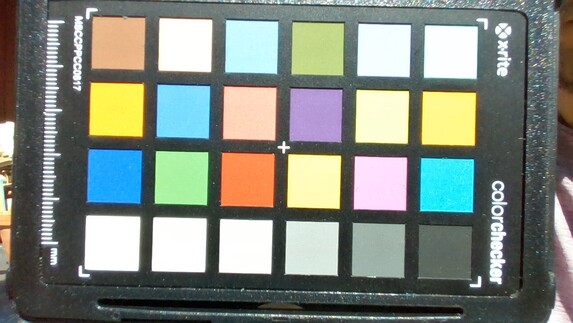
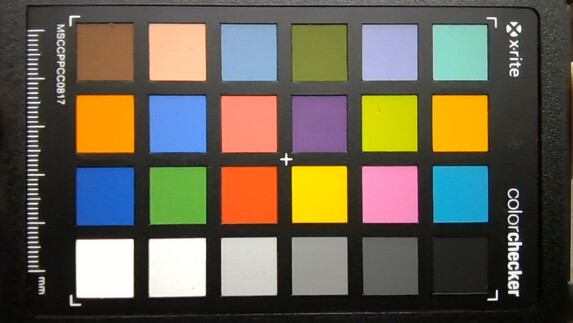
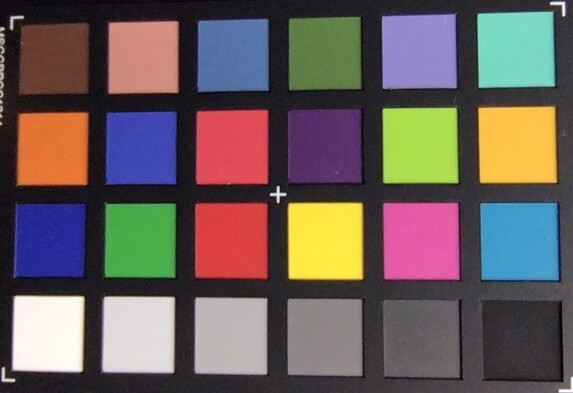
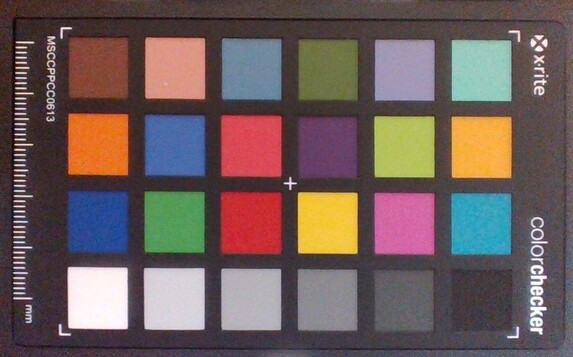
Accessories
Apart from the usual documents (warranty information, quick-start guide), the laptop also comes with a sleeve and a USB-C to headphone jack adapter.
Maintenance
There is no maintenance hatch on the laptop. In order to reach the components, the bottom plate has to be removed. First, all the screws on the bottom of the device need to be loosened. Careful: Two of the screws are hidden beneath the rubber feet in the back. The bottom plate can subsequently be removed with a sharp edge. It is latched fairly tightly onto the base unit.
Warranty
The system comes with a two-year warranty. A warranty extension to three years can be purchased for around 50 Euros (~$60).
Input Devices - Onboard Keyboard Backlighting
Keyboard
The ZenBook is equipped with a backlit chiclet keyboard, which stretches itself across the entire length of the base unit. The smooth, flat keys offer short travel and a distinct actuation point. The QWERTY keys have a size of 16 x 13 mm. Meanwhile, the arrow keys are very small at 7 x 13 mm. As a result, trying to press the arrow-up/-down key often results in accidentally pressing the key above or below it, respectively.
The keyboard area slightly yields when typing. This did not prove to be a major issue. The backlighting offers three brightness levels, which can be switched between via a dedicated function key. Overall, Asus has delivered a keyboard that is suitable for day-to-day use.
Touchpad
The multi-touch ClickPad occupies an area of about 13x6 cm. Thus, a lot of space is available for gesture controls. Fingers effortlessly glide across the smooth surface of the touchpad. The touchpad offers short travel and a distinct actuation point. There are a few extra functions: A numpad can be displayed on the surface of the ClickPad by tapping the top right corner. A swiping gesture from the top left corner opens the Windows calculator.
Display - Bright IPS Screen
The matte, 13.3-inch display has a native resolution of 1920x1080 pixels. While the screen delivers a high maximum brightness (404 cd/m²), the contrast ratio (770:1) is on lower end of the spectrum. For the latter, we consider values of above 1000:1 good.
Unfortunately, we detected flickering at a frequency of 250 Hz at brightness levels of 30% and below. Due to the low frequency, sensitive users may experience headaches and/or eyestrain.
| |||||||||||||||||||||||||
Brightness Distribution: 83 %
Center on Battery: 435 cd/m²
Contrast: 770:1 (Black: 0.565 cd/m²)
ΔE ColorChecker Calman: 2.66 | ∀{0.5-29.43 Ø4.77}
calibrated: 1.19
ΔE Greyscale Calman: 3.65 | ∀{0.09-98 Ø5}
95% sRGB (Argyll 1.6.3 3D)
60% AdobeRGB 1998 (Argyll 1.6.3 3D)
64.9% AdobeRGB 1998 (Argyll 3D)
94.5% sRGB (Argyll 3D)
63.8% Display P3 (Argyll 3D)
Gamma: 2.34
CCT: 7109 K
| Asus ZenBook 13 UX325JA Sharp LQ133M1JW40, IPS, 1920x1080, 13.3" | Samsung Galaxy Book Ion 13.3 BOE087A, IPS (QLED), 1920x1080, 13.3" | Samsung Galaxy Book S Intel BOE07E7, IPS, 1920x1080, 13.3" | Acer Swift 3 SF313-52-71Y7 BOE, NE135FBM-N41, IPS, 2256x1504, 13.5" | Apple MacBook Air 2020 i5 APPA042, IPS, 2560x1600, 13.3" | Huawei MateBook 13 2020 AMD Chi Mei CMN8201 P130ZFA-BA1, IPS, 2160x1440, 13" | HP Envy x360 13-ay0010nr IPS, 1920x1080, 13.3" | |
|---|---|---|---|---|---|---|---|
| Display | 8% | 9% | 8% | 3% | |||
| Display P3 Coverage (%) | 63.8 | 70 10% | 70.1 10% | 70.4 10% | 65.9 3% | ||
| sRGB Coverage (%) | 94.5 | 97.2 3% | 99.8 6% | 97.7 3% | 97.4 3% | ||
| AdobeRGB 1998 Coverage (%) | 64.9 | 71.3 10% | 71.2 10% | 71.7 10% | 67.8 4% | ||
| Response Times | -19% | -27% | -33% | -14% | -5% | -28% | |
| Response Time Grey 50% / Grey 80% * (ms) | 47 ? | 47 ? -0% | 51.2 ? -9% | 55 ? -17% | 38.7 ? 18% | 40.8 ? 13% | 47.6 ? -1% |
| Response Time Black / White * (ms) | 21 ? | 29 ? -38% | 30.4 ? -45% | 31 ? -48% | 30.44 ? -45% | 25.6 ? -22% | 32.4 ? -54% |
| PWM Frequency (Hz) | 250 ? | 208 ? | 117000 ? | 58820 ? | 25000 ? | ||
| Screen | 7% | -7% | 4% | 19% | -17% | 20% | |
| Brightness middle (cd/m²) | 435 | 467 7% | 385 -11% | 474 9% | 430 -1% | 374 -14% | 452.6 4% |
| Brightness (cd/m²) | 404 | 437 8% | 354 -12% | 426 5% | 405 0% | 364 -10% | 438 8% |
| Brightness Distribution (%) | 83 | 88 6% | 88 6% | 82 -1% | 89 7% | 94 13% | 93 12% |
| Black Level * (cd/m²) | 0.565 | 0.29 49% | 0.3 47% | 0.29 49% | 0.32 43% | 0.6 -6% | 0.29 49% |
| Contrast (:1) | 770 | 1610 109% | 1283 67% | 1634 112% | 1344 75% | 623 -19% | 1561 103% |
| Colorchecker dE 2000 * | 2.66 | 4.73 -78% | 3.8 -43% | 2.38 11% | 1.8 32% | 2.9 -9% | 2.67 -0% |
| Colorchecker dE 2000 max. * | 4.73 | 6.07 -28% | 6.4 -35% | 5.88 -24% | 4.6 3% | 7.4 -56% | 4.11 13% |
| Colorchecker dE 2000 calibrated * | 1.19 | 2.2 -85% | 2.69 -126% | 1.6 -34% | 1.36 -14% | ||
| Greyscale dE 2000 * | 3.65 | 4.33 -19% | 4.6 -26% | 3.75 -3% | 1.1 70% | 4.8 -32% | 2.1 42% |
| Gamma | 2.34 94% | 2.34 94% | 2.2 100% | 2.37 93% | 2.16 102% | 2.01 109% | |
| CCT | 7109 91% | 6954 93% | 7424 88% | 6466 101% | 6644 98% | 6631 98% | 6505 100% |
| Color Space (Percent of AdobeRGB 1998) (%) | 60 | 65.3 9% | 65 8% | 64.2 7% | 62.2 4% | ||
| Color Space (Percent of sRGB) (%) | 95 | 97.2 2% | 100 5% | 97.6 3% | 97.6 3% | ||
| Total Average (Program / Settings) | -6% /
2% | -9% /
-7% | -7% /
0% | 4% /
13% | -11% /
-14% | -2% /
11% |
* ... smaller is better
Ex-factory, the color accuracy of the display is good and within the ideal deltaE-2000 color deviation range of less than three (2.7). It does not suffer from a blue tint. We managed to improve the display by calibrating it. This resulted in a lower color deviation of 1.19 and a more balanced grayscale. The display is unable to display the color spaces AdobeRGB (60%) and sRGB (95%) in their entirety.
Display Response Times
| ↔ Response Time Black to White | ||
|---|---|---|
| 21 ms ... rise ↗ and fall ↘ combined | ↗ 16 ms rise | |
| ↘ 5 ms fall | ||
| The screen shows good response rates in our tests, but may be too slow for competitive gamers. In comparison, all tested devices range from 0.1 (minimum) to 240 (maximum) ms. » 45 % of all devices are better. This means that the measured response time is similar to the average of all tested devices (20.2 ms). | ||
| ↔ Response Time 50% Grey to 80% Grey | ||
| 47 ms ... rise ↗ and fall ↘ combined | ↗ 22 ms rise | |
| ↘ 25 ms fall | ||
| The screen shows slow response rates in our tests and will be unsatisfactory for gamers. In comparison, all tested devices range from 0.165 (minimum) to 636 (maximum) ms. » 80 % of all devices are better. This means that the measured response time is worse than the average of all tested devices (31.6 ms). | ||
Screen Flickering / PWM (Pulse-Width Modulation)
| Screen flickering / PWM detected | 250 Hz | ≤ 30 % brightness setting | |
The display backlight flickers at 250 Hz (worst case, e.g., utilizing PWM) Flickering detected at a brightness setting of 30 % and below. There should be no flickering or PWM above this brightness setting. The frequency of 250 Hz is relatively low, so sensitive users will likely notice flickering and experience eyestrain at the stated brightness setting and below. In comparison: 53 % of all tested devices do not use PWM to dim the display. If PWM was detected, an average of 8084 (minimum: 5 - maximum: 343500) Hz was measured. | |||
Performance - Ice Lake-based Asus System
With the ZenBook 13 UX325JA, Asus has created a slim, lightweight, mobile 13.3-inch laptop with more than enough performance for office and web applications. Our test device can be purchased for approximately 1,400 Euros (~$1,660). Other configurations are available as well with prices starting at about 1,080 Euros (~$1,280).
Processor
The ZenBook is powered by a quad-core Core i7-1065G7 (Ice Lake) processor. In this case, it is a ULV variant with a TDP of 15 watts. The CPU has a base clock speed of 1.3 GHz. Via turbo, the clock speed can be increased to between 3.4 GHz (four cores) and 3.9 GHz (single core). Hyper-Threading, which allows each physical core to handle two threads simultaneously, is supported.
In our Cinebench multithread benchmark, the processor initially runs at clock speeds of 3.2 to 3.5 GHz. Subsequently, the clock speeds drop to the 2.5-2.6 GHz range. The single-thread tests were completed at clock speeds of 3 to 3.9 GHz. In battery mode, we observed clock rates of 1.3 to 3.8 GHz (multithread) and 1.5 to 3.1 GHz (single-thread).
By running the Cinebench R15 multithread test in a loop for at least 30 minutes, we determine whether the CPU Turbo Boost is permanently active while on mains. After the first loop, the scores drop by a large margin. Thereafter, the results slowly and steadily drop after each additional loop. Although the Turbo Boost is still permanently active, the frequency increase compared to the base clock speed is low.
* ... smaller is better
System Performance
| PCMark 8 Home Score Accelerated v2 | 3751 points | |
| PCMark 8 Creative Score Accelerated v2 | 4155 points | |
| PCMark 8 Work Score Accelerated v2 | 2802 points | |
| PCMark 10 Score | 4309 points | |
Help | ||
DPC Latencies
| DPC Latencies / LatencyMon - interrupt to process latency (max), Web, Youtube, Prime95 | |
| Apple MacBook Air 2020 i5 | |
| Asus ZenBook 13 UX325JA | |
| Samsung Galaxy Book S Intel | |
| HP Envy x360 13-ay0010nr | |
| Samsung Galaxy Book Ion 13.3 | |
| Huawei MateBook 13 2020 AMD | |
* ... smaller is better
Storage Solution
| Asus ZenBook 13 UX325JA Intel SSD 660p 1TB SSDPEKNW010T8 | Samsung Galaxy Book Ion 13.3 Samsung SSD PM981a MZVLB256HBHQ | Samsung Galaxy Book S Intel 256 GB UFS 3.0 Flash | Acer Swift 3 SF313-52-71Y7 Intel SSD 660p 1TB SSDPEKNW010T8 | Apple MacBook Air 2020 i5 Apple SSD AP0512 | Huawei MateBook 13 2020 AMD WDC PC SN730 SDBPNTY-512G | HP Envy x360 13-ay0010nr Toshiba KBG30ZMV256G | Average Intel SSD 660p 1TB SSDPEKNW010T8 | |
|---|---|---|---|---|---|---|---|---|
| CrystalDiskMark 5.2 / 6 | 35% | -61% | 22% | 9% | -29% | 5% | ||
| Write 4K (MB/s) | 139.7 | 159.6 14% | 37.71 -73% | 187.4 34% | 143.9 3% | 94.8 -32% | 144.5 ? 3% | |
| Read 4K (MB/s) | 56.4 | 48.22 -15% | 11 -80% | 63.8 13% | 45.91 -19% | 45.5 -19% | 54.1 ? -4% | |
| Write Seq (MB/s) | 1265 | 2343 85% | 403.1 -68% | 1776 40% | 1307 3% | 732 -42% | 1445 ? 14% | |
| Read Seq (MB/s) | 1492 | 2184 46% | 769 -48% | 1693 13% | 1435 -4% | 959 -36% | 1446 ? -3% | |
| Write 4K Q32T1 (MB/s) | 402.5 | 342.2 -15% | 155.9 -61% | 492.3 22% | 237.1 -41% | 224.6 -44% | 427 ? 6% | |
| Read 4K Q32T1 (MB/s) | 329.3 | 485.4 47% | 195.6 -41% | 539 64% | 332.7 1% | 365.2 11% | 456 ? 38% | |
| Write Seq Q32T1 (MB/s) | 1786 | 2354 32% | 407.9 -77% | 1770 -1% | 2698 51% | 864 -52% | 1650 ? -8% | |
| Read Seq Q32T1 (MB/s) | 1923 | 3555 85% | 1102 -43% | 1715 -11% | 3394 76% | 1580 -18% | 1728 ? -10% | |
| Write 4K Q8T8 (MB/s) | 899 | 880 ? | ||||||
| Read 4K Q8T8 (MB/s) | 630 | 629 ? | ||||||
| AS SSD | 19% | -78% | 20% | -59% | 42% | -124% | 9% | |
| Seq Read (MB/s) | 1587 | 2980 88% | 945 -40% | 1703 7% | 1153 -27% | 2844 79% | 1135 -28% | 1456 ? -8% |
| Seq Write (MB/s) | 938 | 2175 132% | 349 -63% | 1373 46% | 1367 46% | 2316 147% | 628 -33% | 1404 ? 50% |
| 4K Read (MB/s) | 51 | 52.8 4% | 17.79 -65% | 56.8 11% | 12.95 -75% | 40.76 -20% | 42.49 -17% | 48.7 ? -5% |
| 4K Write (MB/s) | 141.9 | 147.8 4% | 25.69 -82% | 164.4 16% | 24.52 -83% | 96.9 -32% | 96.9 -32% | 131.6 ? -7% |
| 4K-64 Read (MB/s) | 576 | 542 -6% | 373.5 -35% | 584 1% | 665 15% | 1275 121% | 614 7% | 586 ? 2% |
| 4K-64 Write (MB/s) | 584 | 282.4 -52% | 245.4 -58% | 783 34% | 159.5 -73% | 1156 98% | 256.4 -56% | 788 ? 35% |
| Access Time Read * (ms) | 0.083 | 0.077 7% | 0.232 -180% | 0.044 47% | 0.295 -255% | 0.074 11% | 0.162 -95% | 0.07236 ? 13% |
| Access Time Write * (ms) | 0.04 | 0.025 37% | 0.144 -260% | 0.038 5% | 0.163 -308% | 0.039 2% | 0.592 -1380% | 0.07731 ? -93% |
| Score Read (Points) | 785 | 893 14% | 486 -38% | 811 3% | 793 1% | 1600 104% | 770 -2% | 780 ? -1% |
| Score Write (Points) | 820 | 648 -21% | 306 -63% | 1085 32% | 321 -61% | 1485 81% | 416 -49% | 1060 ? 29% |
| Score Total (Points) | 1990 | 1974 -1% | 1014 -49% | 2313 16% | 1528 -23% | 3879 95% | 1567 -21% | 2252 ? 13% |
| Copy ISO MB/s (MB/s) | 1311 | 368.9 -72% | 1401 7% | 1433 9% | 433.2 -67% | 843 -36% | 1469 ? 12% | |
| Copy Program MB/s (MB/s) | 310.3 | 190 -39% | 480.4 55% | 363 17% | 266.4 -14% | 367.9 19% | 484 ? 56% | |
| Copy Game MB/s (MB/s) | 801 | 366.6 -54% | 820 2% | 725 -9% | 620 -23% | 727 -9% | 997 ? 24% | |
| Total Average (Program / Settings) | 27% /
26% | -70% /
-72% | 21% /
21% | -59% /
-59% | 26% /
30% | -77% /
-89% | 7% /
7% |
* ... smaller is better
Continuous read: DiskSpd Read Loop, Queue Depth 8
GPU Performance
Intel's Iris Plus Graphics G7 is responsible for video output. The integrated GPU supports DirectX 12 and clock speeds of up to 1100 MHz. The 3DMark benchmark results match our expectations for this GPU.
| 3DMark 11 Performance | 4380 points | |
| 3DMark Ice Storm Standard Score | 70684 points | |
| 3DMark Cloud Gate Standard Score | 12855 points | |
| 3DMark Fire Strike Score | 2587 points | |
| 3DMark Time Spy Score | 885 points | |
Help | ||
Gaming Performance
The CPU-GPU combination is able to smoothly display a lot of the games in our database on its screen - at HD resolution (1280x720 pixels) and low to medium settings. In many cases, higher resolutions or quality settings are possible. This primarily applies to titles with low hardware demands. A few modern titles such as FIFA 20 and Gears Tactics are also playable.
| BioShock Infinite - 1366x768 High Preset | |
| Acer Swift 3 SF313-52-71Y7 | |
| Average Intel Iris Plus Graphics G7 (Ice Lake 64 EU) (21.1 - 61.5, n=18) | |
| Asus ZenBook 13 UX325JA | |
| Apple MacBook Air 2020 i5 | |
| Tomb Raider - 1366x768 High Preset AA:FX AF:8x | |
| Asus ZenBook 13 UX325JA | |
| Average Intel Iris Plus Graphics G7 (Ice Lake 64 EU) (41.4 - 49.4, n=2) | |
| low | med. | high | ultra | |
|---|---|---|---|---|
| Tomb Raider (2013) | 141.7 | 77.2 | 49.4 | 27.4 |
| BioShock Infinite (2013) | 99.6 | 58.3 | 49 | 18.5 |
| Dota 2 Reborn (2015) | 77.8 | 50.2 | 30.7 | 28 |
| X-Plane 11.11 (2018) | 34.3 | 18.9 | 17.6 | |
| Total War: Three Kingdoms (2019) | 43.4 | 12 | 7.5 | 5.6 |
| Red Dead Redemption 2 (2019) | 21 | 10.6 | ||
| Escape from Tarkov (2020) | 29.3 | 18.5 | 17.6 | |
| Hunt Showdown (2020) | 30.7 | 13.4 | 9.9 | |
| Doom Eternal (2020) | 22.8 | 12.3 | 12.1 | |
| Gears Tactics (2020) | 56.2 | 19.6 | 12.1 | 8.3 |
| F1 2020 (2020) | 45 | 24 | 17 | 11 |
| Death Stranding (2020) | 25.7 | 16.2 | 14.4 | 11.1 |
Emissions - ZenBook UX325 with Moderate Heat Development
System Noise
While idling, the fan often does not spin at all for a completely silent operation. The fan noise slightly picks up under load. We recorded a maximum noise level of 38.5 dB(A) (stress test).
Noise level
| Idle |
| 30.1 / 30.1 / 30.1 dB(A) |
| Load |
| 32.7 / 38.5 dB(A) |
 | ||
30 dB silent 40 dB(A) audible 50 dB(A) loud |
||
min: | ||
| Asus ZenBook 13 UX325JA i7-1065G7, Iris Plus Graphics G7 (Ice Lake 64 EU) | Samsung Galaxy Book Ion 13.3 i5-10210U, UHD Graphics 620 | Acer Swift 3 SF313-52-71Y7 i7-1065G7, Iris Plus Graphics G7 (Ice Lake 64 EU) | Apple MacBook Air 2020 i5 i5-1030NG7, Iris Plus Graphics G7 (Ice Lake 64 EU) | Huawei MateBook 13 2020 AMD R5 3500U, Vega 8 | HP Envy x360 13-ay0010nr R5 4500U, Vega 6 | Average Intel Iris Plus Graphics G7 (Ice Lake 64 EU) | Average of class Subnotebook | |
|---|---|---|---|---|---|---|---|---|
| Noise | -1% | 2% | -10% | 7% | -2% | 3% | 10% | |
| off / environment * (dB) | 30.1 | 30.7 -2% | 30.3 -1% | 30 -0% | 27.2 10% | 28 7% | 28.4 ? 6% | 24.2 ? 20% |
| Idle Minimum * (dB) | 30.1 | 30.7 -2% | 30.3 -1% | 30 -0% | 27.2 10% | 28 7% | 28.6 ? 5% | 24.3 ? 19% |
| Idle Average * (dB) | 30.1 | 30.7 -2% | 30.3 -1% | 30 -0% | 27.2 10% | 28 7% | 28.7 ? 5% | 24.6 ? 18% |
| Idle Maximum * (dB) | 30.1 | 30.7 -2% | 30.3 -1% | 30 -0% | 27.2 10% | 28.5 5% | 29 ? 4% | 25.5 ? 15% |
| Load Average * (dB) | 32.7 | 36.6 -12% | 31.7 3% | 45.5 -39% | 31.8 3% | 41.1 -26% | 33.4 ? -2% | 33.7 ? -3% |
| Witcher 3 ultra * (dB) | 38.6 | 35.8 7% | ||||||
| Load Maximum * (dB) | 38.5 | 36.3 6% | 32.7 15% | 45.8 -19% | 38.3 1% | 43.5 -13% | 37.9 ? 2% | 41.9 ? -9% |
* ... smaller is better
Stress Test & Temperature
The results of our stress test (running Prime95 and FurMark for at least one hour) in battery mode do not deviate from the results while on mains. The processor and graphics card are only able to maintain faster speeds for a few minutes. Subsequently, they throttle to the 500-800 MHz (CPU) and 500-MHz (GPU) range. The stress test represents an extreme scenario that does not occur during daily use. We use this test to determine whether the system is stable under maximum load.
Due to the low clock speeds, the low heat development should not come as a surprise. During the stress test, we registered peak temperatures of below 40 °C. The temperatures during daily use are on a reasonable level.
(+) The maximum temperature on the upper side is 39.7 °C / 103 F, compared to the average of 35.9 °C / 97 F, ranging from 21.4 to 59 °C for the class Subnotebook.
(+) The bottom heats up to a maximum of 39.9 °C / 104 F, compared to the average of 39.3 °C / 103 F
(+) In idle usage, the average temperature for the upper side is 26.4 °C / 80 F, compared to the device average of 30.8 °C / 87 F.
(+) The palmrests and touchpad are cooler than skin temperature with a maximum of 30.3 °C / 86.5 F and are therefore cool to the touch.
(-) The average temperature of the palmrest area of similar devices was 28.2 °C / 82.8 F (-2.1 °C / -3.7 F).
| Asus ZenBook 13 UX325JA i7-1065G7, Iris Plus Graphics G7 (Ice Lake 64 EU) | Samsung Galaxy Book Ion 13.3 i5-10210U, UHD Graphics 620 | Samsung Galaxy Book S Intel i5-L16G7, UHD Graphics G7 (Lakefield GT2 64 EU) | Acer Swift 3 SF313-52-71Y7 i7-1065G7, Iris Plus Graphics G7 (Ice Lake 64 EU) | Apple MacBook Air 2020 i5 i5-1030NG7, Iris Plus Graphics G7 (Ice Lake 64 EU) | Huawei MateBook 13 2020 AMD R5 3500U, Vega 8 | HP Envy x360 13-ay0010nr R5 4500U, Vega 6 | Average Intel Iris Plus Graphics G7 (Ice Lake 64 EU) | Average of class Subnotebook | |
|---|---|---|---|---|---|---|---|---|---|
| Heat | -0% | 8% | 13% | -10% | -3% | -5% | -3% | -1% | |
| Maximum Upper Side * (°C) | 39.7 | 41.8 -5% | 38.1 4% | 33.5 16% | 48 -21% | 39.3 1% | 44.8 -13% | 41.1 ? -4% | 41.7 ? -5% |
| Maximum Bottom * (°C) | 39.9 | 43 -8% | 40 -0% | 35.6 11% | 40 -0% | 40.2 -1% | 43.8 -10% | 42.5 ? -7% | 43.8 ? -10% |
| Idle Upper Side * (°C) | 28.7 | 26.6 7% | 24.8 14% | 24.9 13% | 33 -15% | 30.3 -6% | 27 6% | 27.9 ? 3% | 26.7 ? 7% |
| Idle Bottom * (°C) | 28.5 | 27.2 5% | 24.8 13% | 25.4 11% | 30 -5% | 30.5 -7% | 29.2 -2% | 29.1 ? -2% | 27.3 ? 4% |
* ... smaller is better
Speakers
The stereo speakers are located near the front on the bottom of the device. They deliver fairly good sound, although they are slightly lacking in terms of bass. The maximum volume level is fairly low. A better audio experience can be achieved with headphones or external speakers. Since the popular headphone jack is missing from the port selection, Asus has included a USB-C to headphone jack adapter.
Asus ZenBook 13 UX325JA audio analysis
(-) | not very loud speakers (64.8 dB)
Bass 100 - 315 Hz
(±) | reduced bass - on average 12.4% lower than median
(-) | bass is not linear (15.4% delta to prev. frequency)
Mids 400 - 2000 Hz
(±) | higher mids - on average 5% higher than median
(+) | mids are linear (6.9% delta to prev. frequency)
Highs 2 - 16 kHz
(+) | balanced highs - only 2% away from median
(+) | highs are linear (6.3% delta to prev. frequency)
Overall 100 - 16.000 Hz
(±) | linearity of overall sound is average (18.6% difference to median)
Compared to same class
» 54% of all tested devices in this class were better, 6% similar, 39% worse
» The best had a delta of 5%, average was 18%, worst was 53%
Compared to all devices tested
» 41% of all tested devices were better, 8% similar, 51% worse
» The best had a delta of 4%, average was 24%, worst was 134%
Energy Management - Asus Laptop with Long Battery Life
Energy Consumption
The energy consumption of the ZenBook UX325 is nothing out of the ordinary. We recorded a maximum consumption of 9 watts while idling. This value increases to up to 36 watts during our stress test (running Prime95 and FurMark for at least one hour). The included charger is rated for 65 watts.
| Off / Standby | |
| Idle | |
| Load |
|
Key:
min: | |
| Asus ZenBook 13 UX325JA i7-1065G7, Iris Plus Graphics G7 (Ice Lake 64 EU) | Samsung Galaxy Book Ion 13.3 i5-10210U, UHD Graphics 620 | Samsung Galaxy Book S Intel i5-L16G7, UHD Graphics G7 (Lakefield GT2 64 EU) | Acer Swift 3 SF313-52-71Y7 i7-1065G7, Iris Plus Graphics G7 (Ice Lake 64 EU) | Apple MacBook Air 2020 i5 i5-1030NG7, Iris Plus Graphics G7 (Ice Lake 64 EU) | Huawei MateBook 13 2020 AMD R5 3500U, Vega 8 | HP Envy x360 13-ay0010nr R5 4500U, Vega 6 | Average Intel Iris Plus Graphics G7 (Ice Lake 64 EU) | Average of class Subnotebook | |
|---|---|---|---|---|---|---|---|---|---|
| Power Consumption | -6% | 26% | 21% | -2% | -43% | -22% | -34% | -43% | |
| Idle Minimum * (Watt) | 2.4 | 2.2 8% | 2.5 -4% | 1.8 25% | 2.4 -0% | 4.71 -96% | 3.9 -63% | 3.91 ? -63% | 3.99 ? -66% |
| Idle Average * (Watt) | 4.6 | 5.9 -28% | 4.8 -4% | 4.6 -0% | 6.8 -48% | 8.65 -88% | 5.8 -26% | 7.33 ? -59% | 6.86 ? -49% |
| Idle Maximum * (Watt) | 9 | 8.9 1% | 6 33% | 6.1 32% | 10.5 -17% | 9.42 -5% | 6 33% | 9.16 ? -2% | 8.49 ? 6% |
| Load Average * (Watt) | 36 | 46 -28% | 14.9 59% | 27.4 24% | 25.7 29% | 34.23 5% | 41.5 -15% | 39.2 ? -9% | 43.9 ? -22% |
| Witcher 3 ultra * (Watt) | 27 | 25.5 6% | 24.5 9% | ||||||
| Load Maximum * (Watt) | 36 | 34 6% | 20.1 44% | 27 25% | 30.4 16% | 47.1 -31% | 50.4 -40% | 49.8 ? -38% | 67.1 ? -86% |
* ... smaller is better
Battery Life
The runtimes of the ZenBook 13 are outstanding. In our Wi-Fi test (periodically accessing web pages with the help of a script) and our video test (playing the short film Big Buck Bunny (H.264 codec, FHD) in a loop), the 13.3-inch laptop lasts 13:47 h and 16:32 h, respectively. We reached a maximum runtime of almost 27 h.
| Asus ZenBook 13 UX325JA i7-1065G7, Iris Plus Graphics G7 (Ice Lake 64 EU), 67 Wh | Samsung Galaxy Book Ion 13.3 i5-10210U, UHD Graphics 620, 66.9 Wh | Samsung Galaxy Book S Intel i5-L16G7, UHD Graphics G7 (Lakefield GT2 64 EU), 42 Wh | Acer Swift 3 SF313-52-71Y7 i7-1065G7, Iris Plus Graphics G7 (Ice Lake 64 EU), 54.5 Wh | Apple MacBook Air 2020 i5 i5-1030NG7, Iris Plus Graphics G7 (Ice Lake 64 EU), 49.9 Wh | Huawei MateBook 13 2020 AMD R5 3500U, Vega 8, 41.7 Wh | HP Envy x360 13-ay0010nr R5 4500U, Vega 6, 51 Wh | Average of class Subnotebook | |
|---|---|---|---|---|---|---|---|---|
| Battery runtime | -12% | -10% | -27% | -22% | -52% | -11% | -6% | |
| Reader / Idle (h) | 26.6 | 31.5 18% | 21.4 -20% | 31.9 20% | 30.7 ? 15% | |||
| H.264 (h) | 16.5 | 12 -27% | 10.5 -36% | 10.7 -35% | 8.8 -47% | 16.7 ? 1% | ||
| WiFi v1.3 (h) | 13.8 | 9.5 -31% | 9.9 -28% | 10.3 -25% | 10.3 -25% | 5.3 -62% | 11.8 -14% | 13.4 ? -3% |
| Load (h) | 3.1 | 2.4 -23% | 3.9 26% | 2.3 -26% | 2.9 -6% | 1.6 -48% | 1.9 -39% | 1.929 ? -38% |
Pros
Cons
Verdict
Mobility is very clearly the focus of the ZenBook 13. The installed 67-Wh battery allows for real-world runtimes of around 13 to 16 hours. Thanks to its lightweight construction, the laptop has a weight of only about 1.1 kg (~2.43 lbs). As a result, however, the slim and compact metal chassis is somewhat lacking in terms of rigidity.
The Asus ZenBook UX325JA is a long-lasting mobile companion.
The omission of a proprietary AC connector further reinforces the mobility aspect of the laptop. Instead, the system can be recharged via Thunderbolt 3 with a USB Type-C charger. Thus, most of the common USB chargers are suitable for use as an energy source. According to Asus, the battery can be charged at between 5 and 20 volts.
On the inside of the system, there is an Ice Lake Core i7 processor with more than enough performance for office and web applications, while faster graphics performance can be achieved with an external GPU. Since Asus has included two TB3 ports, an external GPU - or alternatively, a docking station - can be connected at the same time as the charger.
Despite its compact construction, the system only develops a moderate amount of heat. Similarly, the noise level is fairly low - at least while idling or under low loads. Meanwhile, the IPS Full HD screen shines with good viewing angles, a great color accuracy, a good color-space coverage, and a high maximum brightness. That being said, the contrast ratio is somewhat low.
The installed NVMe SSD offers a lot of storage space (1 TB) and fast transfer rates. While it is possible to swap out the SSD, the case has to be opened in order to achieve this. Since there are no RAM slots and the system memory is soldered (16 GB, dual-channel mode), it cannot be upgraded. The backlit keyboard has proven itself to be suitable for daily use.
Asus ZenBook 13 UX325JA
- 08/17/2020 v7 (old)
Sascha Mölck




